Parametric Analysis of Steel Studs to Reduce Thermal Bridges in Light Steel Framing Construction Systems
Abstract
1. Introduction
2. Materials and Methods
2.1. Materials
2.2. Methods
Methodology and Procedures
2.3. Parametric Analysis Definition
2.4. Numerical Simulation of LSF System
- Side 1 (simulating indoor conditions) temperature: 8 °C for 480 min, increasing by 2 °C every 480 min until reaching 30 °C.
- Side 2 (simulating outdoor conditions) temperature: 18 °C for 480 min, increasing by 2 °C every 480 min until 40 °C is reached.
3. Results
3.1. Simulation of Steel Studs
3.2. Numerical Model Calibration
3.3. Simulation Results with Optimized Steel Studs for Different Insulation Thickness
4. Conclusions
- The addition of a steel stud significantly increases heat flux, adding 3.68 W/m2 to the heat flux of the wall panel without insulation, highlighting the opportunity to modify the web section to reduce thermal bridging.
- A weight reduction in the steel studs can be an effective strategy for the mitigation of heat flux and enhancing the thermal performance of the system. In this study, the volume of the web was reduced by 20% in Group 1.
- Modifying the web section, as in Group 3, results in a significant reduction in the heat flux (0.52 W/m2 to 0.02 W/m2), although less than with the introduction of slots and/or the use of a less-conductive material.
- The shape of the slots influences heat flux: rectangular shapes, aligned vertically, increase the path of heat flux through the metal, effectively improving thermal performance.
- The most effective strategy for enhancing the thermal performance of the steel studs was the use of a less-conductive material, such as polyamide, within the web section (Group 2). This corresponds to a reduction in the heat flux between 3.16 W/m2 and 0.21 W/m2 between the different types of insulation.
- As insulation thickness increases, the impact of the modified steel studs becomes less pronounced, with the potential for reduction diminishing and becoming less evident in highly insulated configurations.
Author Contributions
Funding
Data Availability Statement
Conflicts of Interest
References
- European Commission. Energy Efficiency in Buildings; European Commission: Brussels, Belgium, 2020. [Google Scholar]
- The Official Journal of the European Union. Directive 8(EU) 2018/844 of the European Parliament and of the Council on the Energy Performance of Buildings and on Energy Efficiency; The Official Journal of the European Union: Brussels, Belgium, 2018. [Google Scholar]
- The Official Journal of the European Union. Directive (EU) 2018/2001 of the European Parliament and of the Council on the Promotion of the Use of Energy from Renewable Sources; The Official Journal of the European Union: Brussels, Belgium, 2018. [Google Scholar]
- Figueiredo, A.; Almeida, R.M.S.F.; Vicente, R.; Ferreira, V.M. Impact of Heating Strategies towards Energy-Efficient Buildings. Energy Build. 2024, 315, 114287. [Google Scholar] [CrossRef]
- Sengupta, A.; Douaa, A.A.; Kazanci, O.B.; Shinoda, J.; Breesch, H.; Steeman, M. Building and System Design’s Impact on Thermal Resilience to Overheating during Heatwaves: An Uncertainty and Sensitivity Analysis. Build. Environ. 2024, 265, 112031. [Google Scholar] [CrossRef]
- Figueiredo, A.; Figueira, J.; Vicente, R.; Maio, R. Thermal Comfort and Energy Performance: Sensitivity Analysis to Apply the Passive House Concept to the Portuguese Climate. Build. Environ. 2016, 103, 276–288. [Google Scholar] [CrossRef]
- Gonçalves, M.; Figueiredo, A.; Almeida, R.M.S.F.; Vicente, R.; Samagaio, A.; Kośny, J. Thermal Performance Evaluation of a Light Steel Framing Building with Macroencapsulated Phase Change Materials in a Mediterranean Climate. Energy Build. 2024, 323, 114837. [Google Scholar] [CrossRef]
- Roque, E.; Vicente, R.; Almeida, R.M.S.F. Opportunities of Light Steel Framing towards Thermal Comfort in Southern European Climates: Long-Term Monitoring and Comparison with the Heavyweight Construction. Build. Environ. 2021, 200, 107937. [Google Scholar] [CrossRef]
- Roque, E.; Vicente, R.; Almeida, R.M.S.F.; Ferreira, V.M. Energy Consumption in Intermittently Heated Residential Buildings: Light Steel Framing vs Hollow Brick Masonry Constructive System. J. Build. Eng. 2021, 43, 103024. [Google Scholar] [CrossRef]
- Roque, E.; Vicente, R.; Almeida, R.M.S.F.; Ferreira, V.M. The Impact of Thermal Inertia on the Indoor Thermal Environment of Light Steel Framing Constructions. Energies 2022, 15, 3061. [Google Scholar] [CrossRef]
- Soares, N.; Santos, P.; Gervásio, H.; Costa, J.J.; Silva, L.S. Energy Efficiency and Thermal Performance of Lightweight Steel-Framed (LSF) Construction: A Review. Renew. Sustain. Energy Rev. 2017, 78, 194–209. [Google Scholar] [CrossRef]
- Martins, C.; Santos, P.; Silva, L.S. Lightweight Steel-Framed Thermal Bridges Mitigation Strategies: A Parametric Study. J. Build. Phys. 2016, 39, 342–372. [Google Scholar] [CrossRef]
- Ge, H.; Baba, F. Dynamic Effect of Thermal Bridges on the Energy Performance of a Low-Rise Residential Building. Energy Build. 2015, 105, 106–118. [Google Scholar] [CrossRef]
- Sun, K.; Zheng, C.; Wang, X. Thermal Performance and Thermal Transmittance Prediction of Novel Light-Gauge Steel-Framed Straw Walls. J. Build. Eng. 2023, 67, 105973. [Google Scholar] [CrossRef]
- Santos, P.; Lopes, P.; Abrantes, D. Thermal Performance of Load-Bearing, Lightweight, Steel-Framed Partition Walls Using Thermal Break Strips: A Parametric Study. Energies 2022, 15, 9271. [Google Scholar] [CrossRef]
- Tadeu, A.; Simões, I.; Simões, N.; Prata, J. Simulation of Dynamic Linear Thermal Bridges Using a Boundary Element Method Model in the Frequency Domain. Energy Build. 2011, 43, 3685–3695. [Google Scholar] [CrossRef]
- Larbi, A.B. Statistical Modelling of Heat Transfer for Thermal Bridges of Buildings. Energy Build. 2005, 37, 945–951. [Google Scholar] [CrossRef]
- Gorgolewski, M. Developing a Simplified Method of Calculating U-Values in Light Steel Framing. Build. Environ. 2007, 42, 230–236. [Google Scholar] [CrossRef]
- Zalewski, L.; Lassue, S.; Rousse, D.; Boukhalfa, K. Experimental and Numerical Characterization of Thermal Bridges in Prefabricated Building Walls. Energy Convers. Manag. 2010, 51, 2869–2877. [Google Scholar] [CrossRef]
- Atsonios, I.A.; Mandilaras, I.D.; Kontogeorgos, D.A.; Founti, M.A. Two New Methods for the In-Situ Measurement of the Overall Thermal Transmittance of Cold Frame Lightweight Steel-Framed Walls. Energy Build. 2018, 170, 183–194. [Google Scholar] [CrossRef]
- Stromberg, J. Development of Dry Composite Construction Systems Based on Seel in Residential Applications: Final Report; Office for Official Publications of the European Communities (EUR-OP): Luxembourg, 2002; ISBN 9289439467. [Google Scholar]
- Santos, P. Energy Efficiency of Lightweight Steel-Framed Buildings. In Energy Efficient Buildings; InTech: Shinjuku, Japan, 2017. [Google Scholar]
- Baskar, R.; Duraimurugan, K.S.K. Structural Performance of Cold-Formed Steel Channel Joist with Web Openings Subjected to Bending. Matéria 2024, 29, 839. [Google Scholar] [CrossRef]
- Pham, N.H. Investigation of Web Hole Effects on Capacities of Cold-Formed Steel Channel Members; Lecture Notes in Civil Engineering; Springer Science and Business Media Deutschland GmbH: Berlin, Germany, 2023; Volume 235, pp. 161–175. [Google Scholar]
- Francis, R.; Shabhari, A.; Chandrasekar, D.; Jeyapragasam, V.V.K. Investigation of Local Buckling Behavior of Web Perforated Plain Channel Stub Columns. J. Constr. Steel Res. 2024, 222, 108978. [Google Scholar] [CrossRef]
- Wang, W.; Roy, K.; Fang, Z.; Ananthi, G.B.G.; Lim, J.B.P. Web Crippling Behaviour of Cold-Formed Steel Channels with Elongated Un-Stiffened and Edge-Stiffened Web Holes under End-Two-Flange Loading Condition. Thin-Walled Struct. 2024, 195. [Google Scholar] [CrossRef]
- Živaljević, V.; Jovanović, Đ.; Kovačević, D.; Džolev, I. The Influence of Web Holes on the Behaviour of Cold-Formed Steel Members: A Review. Buildings 2022, 12, 1091. [Google Scholar] [CrossRef]
- Zhao, J.; He, J.; Chen, B.; Zhang, W.; Yu, S. Test and Direct Strength Method on Slotted Perforated Cold-Formed Steel Channels Subjected to Eccentric Compression. Eng. Struct. 2023, 285. [Google Scholar] [CrossRef]
- He, Z.; Jian, Y.; Zhou, X.; Jin, S. Local-Distortional Interactive Behavior and Design of Cold-Formed Steel C-Sections with & without Slotted Holes. J. Build. Eng. 2023, 79, 107812. [Google Scholar] [CrossRef]
- Pham, N.H. Numerical Investigation of Cold-Rolled Aluminium Alloy Stub Columns with Perforations Undergoing Local Buckling. Iran. J. Sci. Technol.—Trans. Civ. Eng. 2023, 47, 3453–3463. [Google Scholar] [CrossRef]
- Paul, B.; Roy, K.; Ji, Y.; Fang, Z.; Sivaji, V.; Lim, J.B.P. Moment Capacity of Perforated Cold-Formed Aluminium Channels–Tests, Analysis, and Design. Thin-Walled Struct. 2024, 204. [Google Scholar] [CrossRef]
- Vu, Q.A.; Pham, N.H.; Thinh, V.T.; Nguyen, N.T. Overview on Research on the Strength and Behavior of Cold-Formed Steel Members with Perforations. In Proceedings of the E3S Web of Conferences, Nantes, France, 28–30 August 2024; EDP Sciences: Les Ulis, France, 2024; Volume 533. [Google Scholar]
- Santos, P.; Lopes, P.; Abrantes, D. Thermal Performance of Lightweight Steel Framed Facade Walls Using Thermal Break Strips and ETICS: A Parametric Study. Energies 2023, 16, 1699. [Google Scholar] [CrossRef]
- Alekperov, R.; Aksenov, I. Decrease of Cold-Formed Slotted Studs Heat Conductivity by Slots Shape Modification. In Proceedings of the E3S Web of Conferences, Bucharest, Romania, 26–29 May 2019; EDP Sciences: Les Ulis, France, 2019; Volume 97. [Google Scholar]
- Garifullin, M.; Sinelnikov, A.; Bronzova, M.; Kovacic, B.; Kamnik, R. Buckling Behavior of Cold-Formed Studs with Thermal Perforations. In MATEC Web of Conferences; EDP Sciences: Les Ulis, France, 2016. [Google Scholar]
- Blomberg, T.R.; Claesson, J. Heat Transmission Through Walls with Slotted Steel Studs; American Society of Heating, Refrigerating and Air-Conditioning Engineers (ASHRAE): Clearwater Beach, FL, USA, 1998; pp. 621–628. [Google Scholar]
- Höglund, T.; Burstrand, H. Slotted Steel Studs to Reduce Thermal Bridges in Insulated Walls. Thin-Walled Struct. 1998, 32, 81–109. [Google Scholar] [CrossRef]
- Liu, C.; Mao, X.; He, L.; Chen, X.; Yang, Y.; Yuan, J. A New Demountable Light-Gauge Steel Framed Wall: Flexural Behavior, Thermal Performance and Life Cycle Assessment. J. Build. Eng. 2022, 47, 103856. [Google Scholar] [CrossRef]
- Santos, P.; Martins, C.; Silva, L.S.; Bragança, L. Thermal Performance of Lightweight Steel Framed Wall: The Importance of Flanking Thermal Losses. J. Build. Phys. 2014, 38, 81–98. [Google Scholar] [CrossRef]
- Figueiredo, A.; Rebelo, F.; Samagaio, A.; Vicente, R.; Lira, J. Design and Thermal Characterization of Two Construction Solutions with and without Incorporation of Macroencapsulated PCM. Infrastructures 2022, 7, 27. [Google Scholar] [CrossRef]
- Nieminen, J.; Salonvaara, M. Hygrothermal Performance of Light Steel-Framed Walls; Technical Research Centre of Finland: Espoo, Finland, 2000. [Google Scholar]
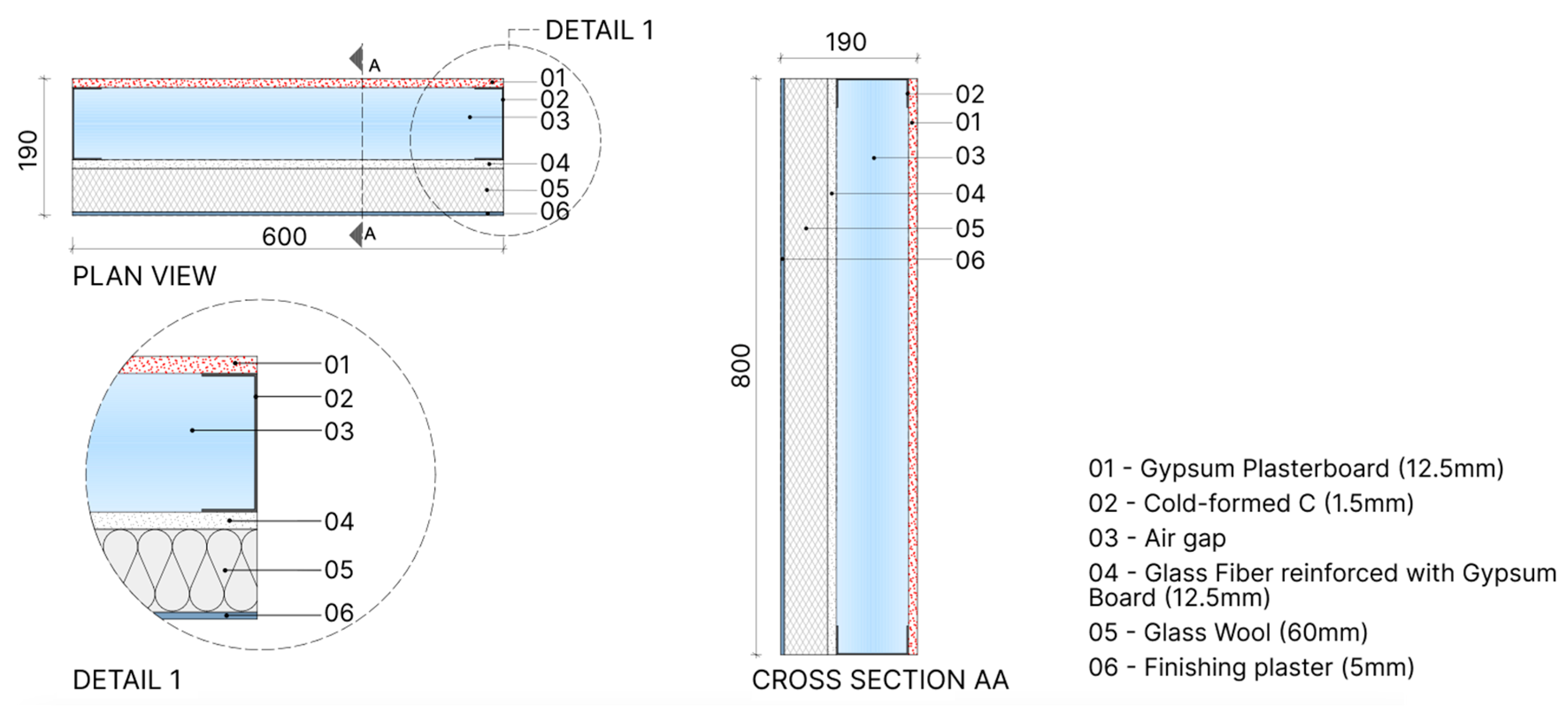
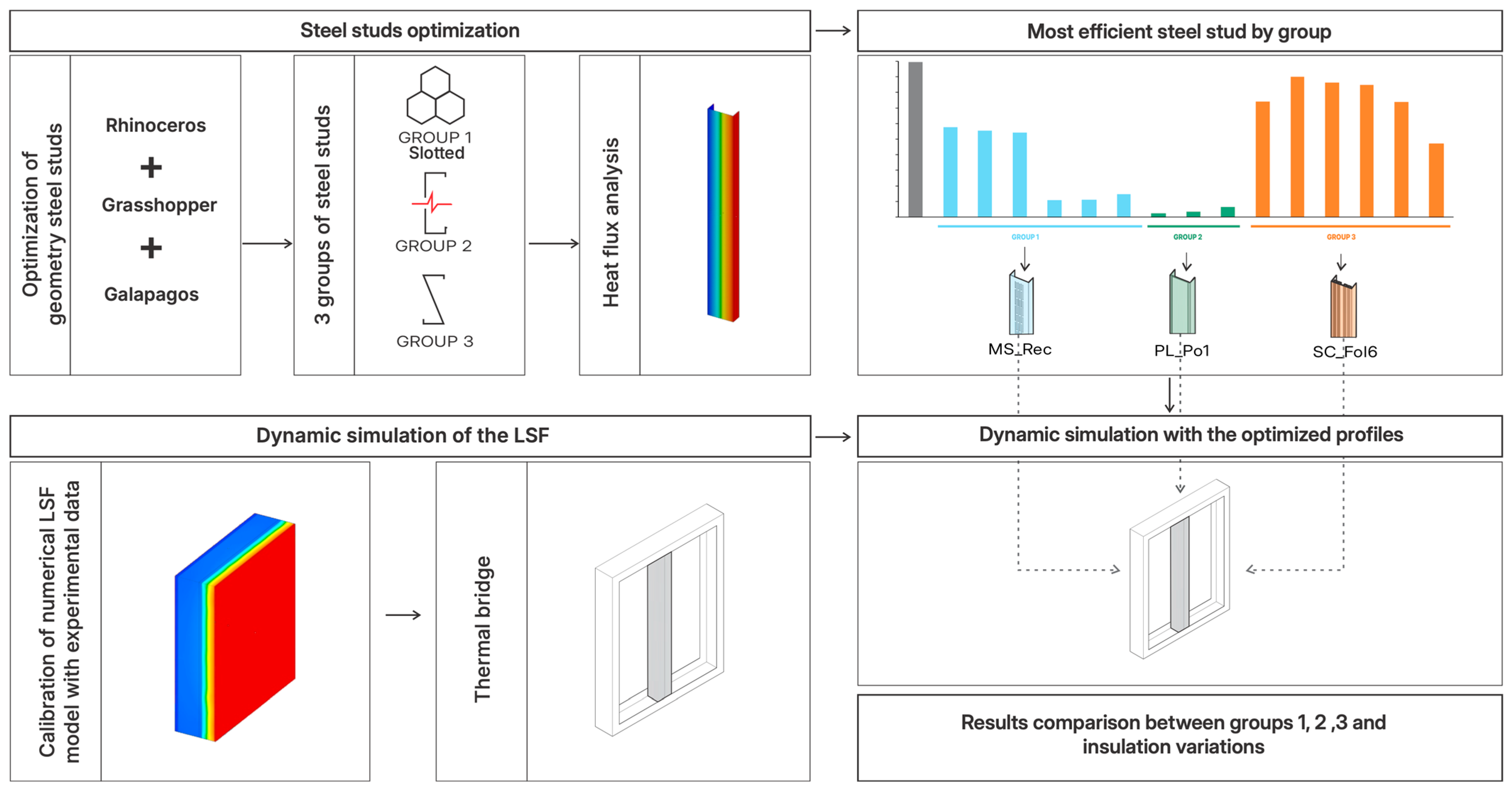
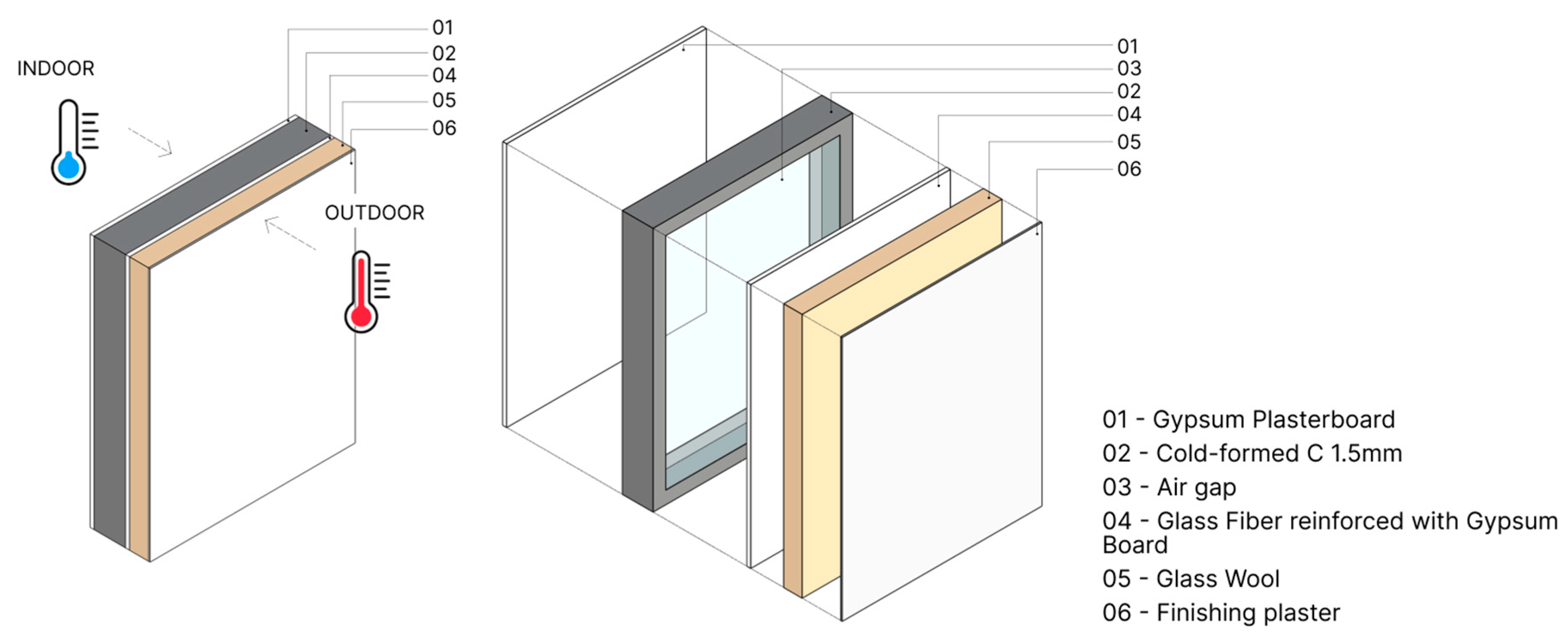

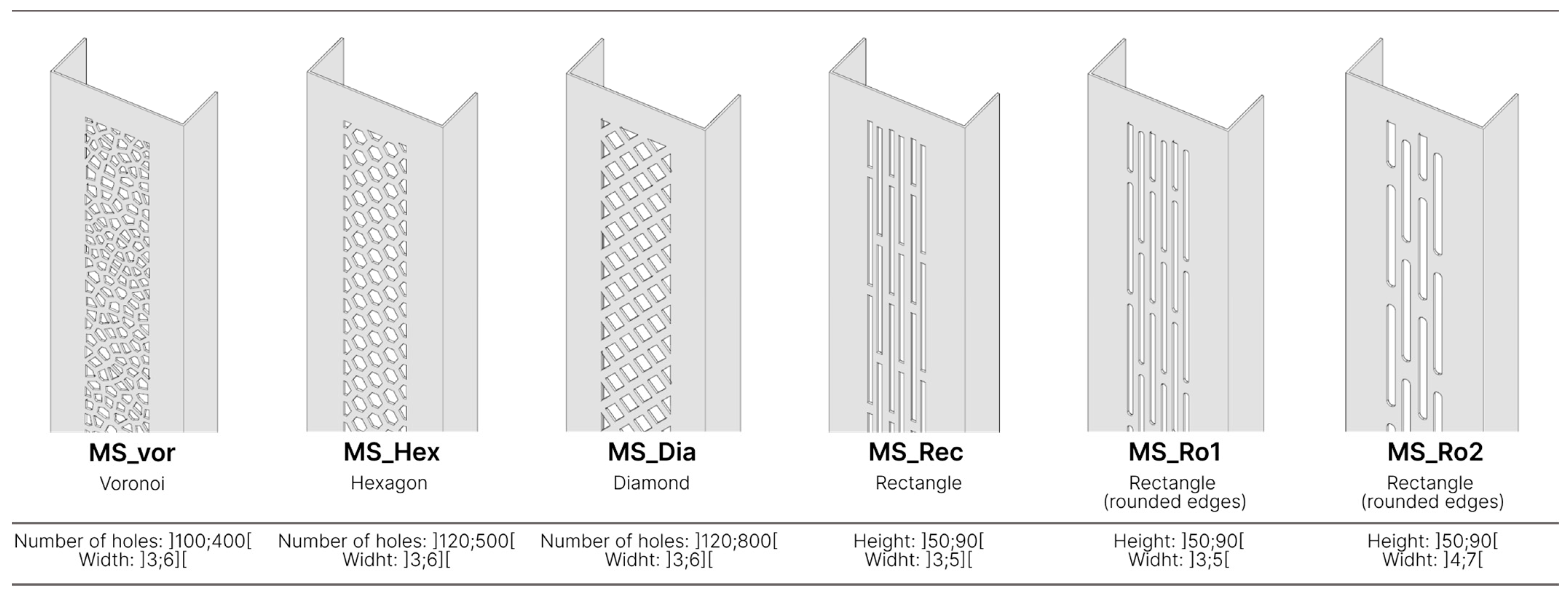
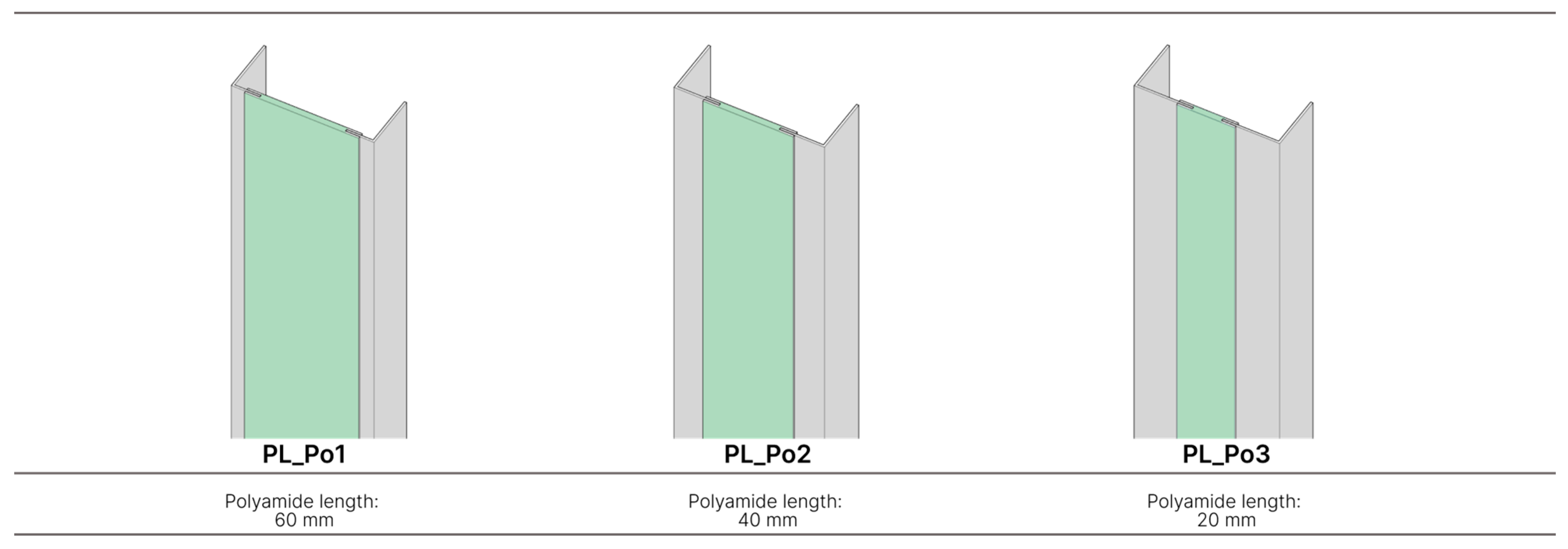
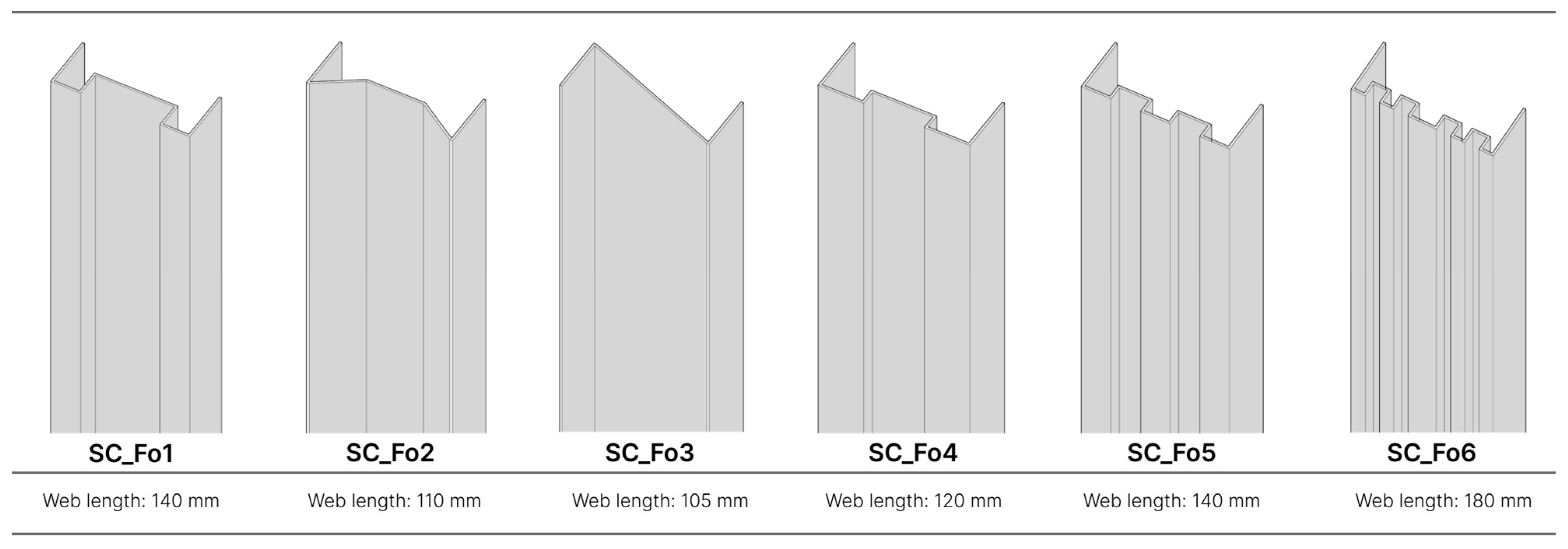
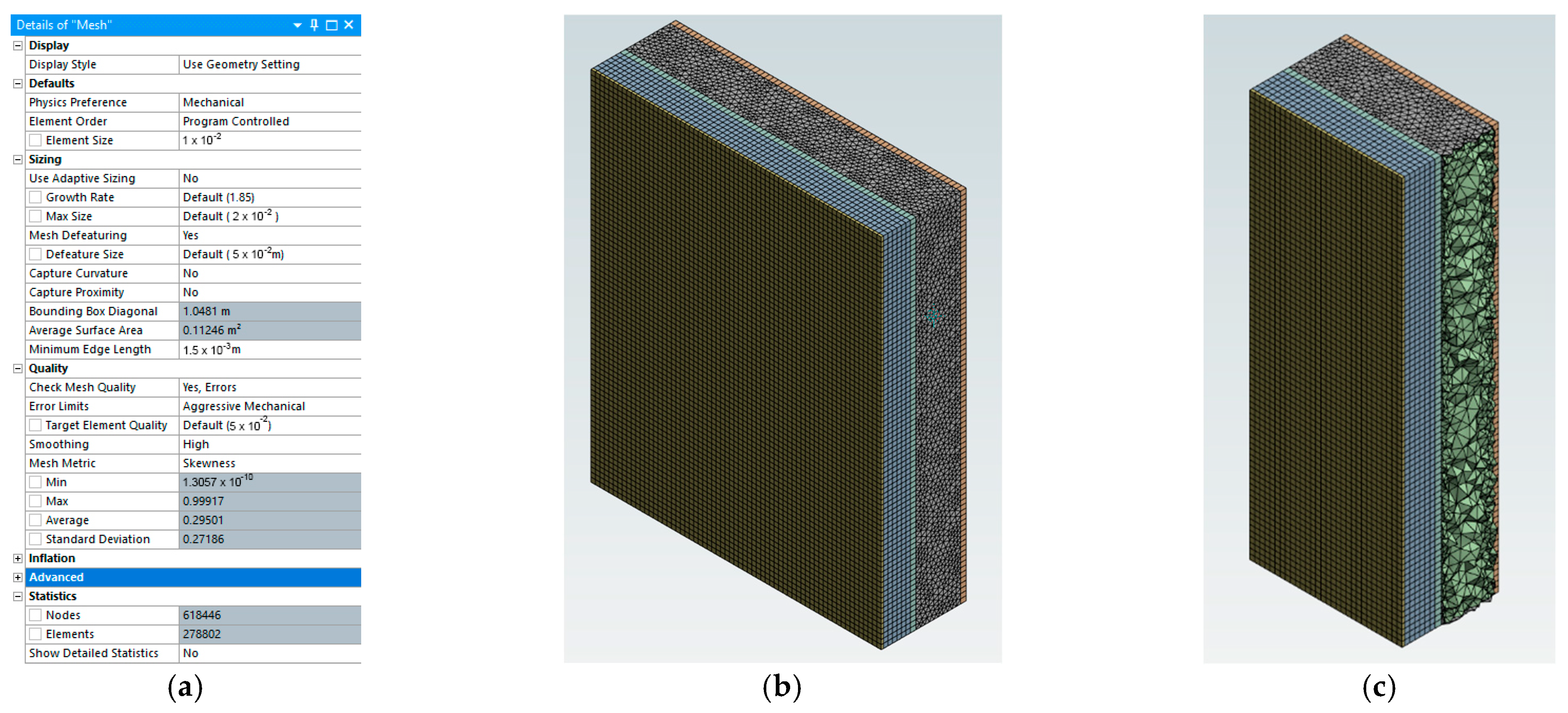
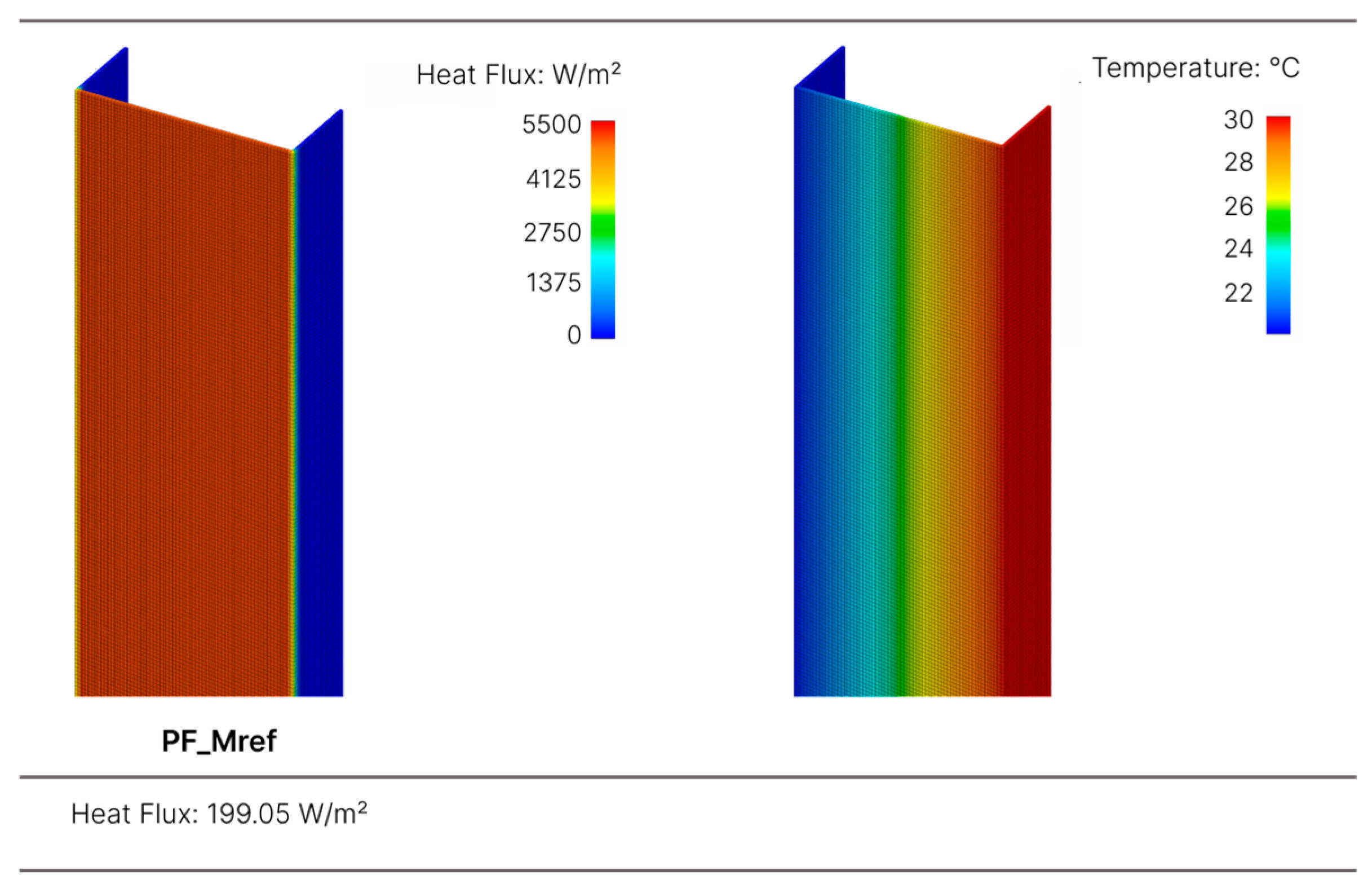
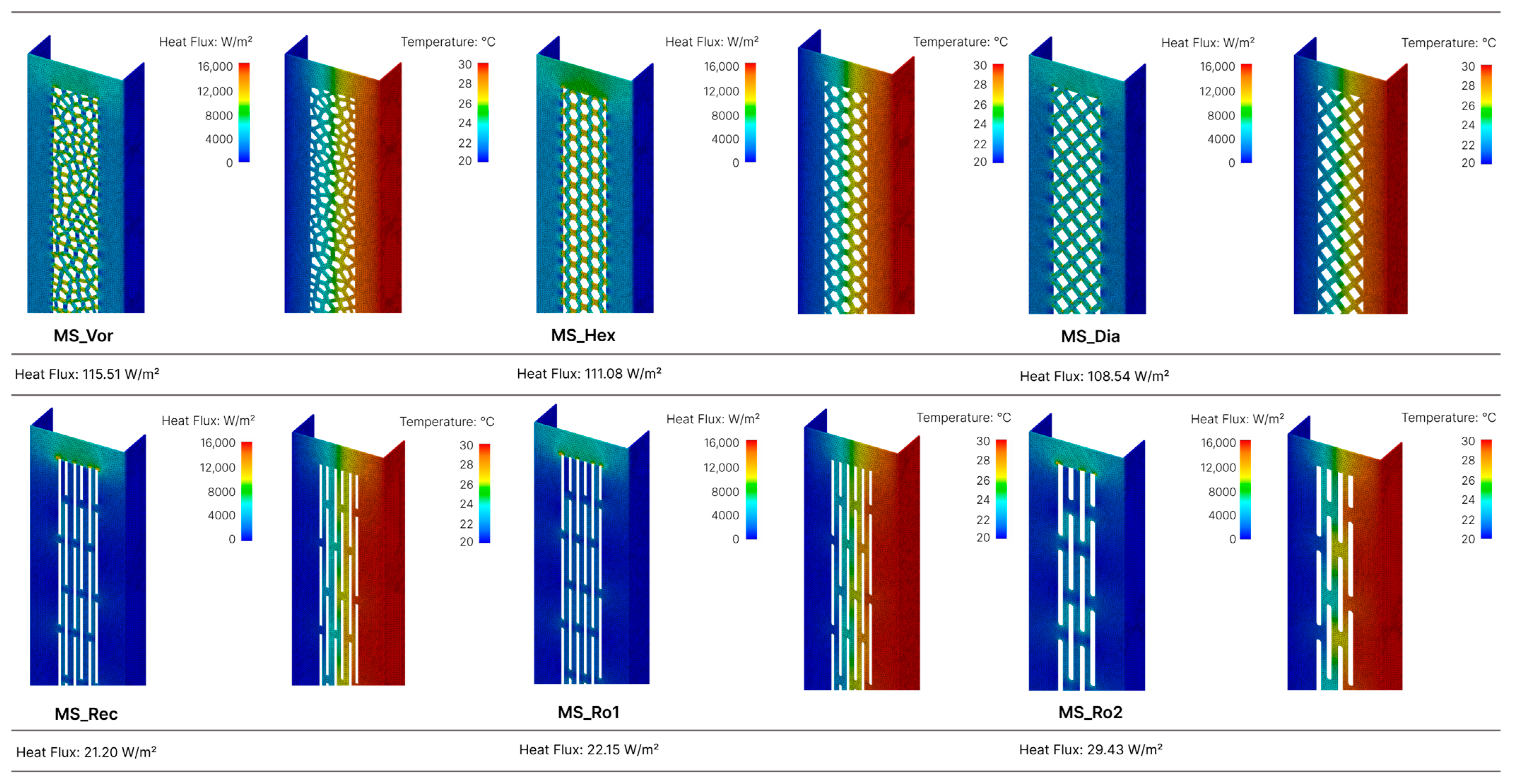

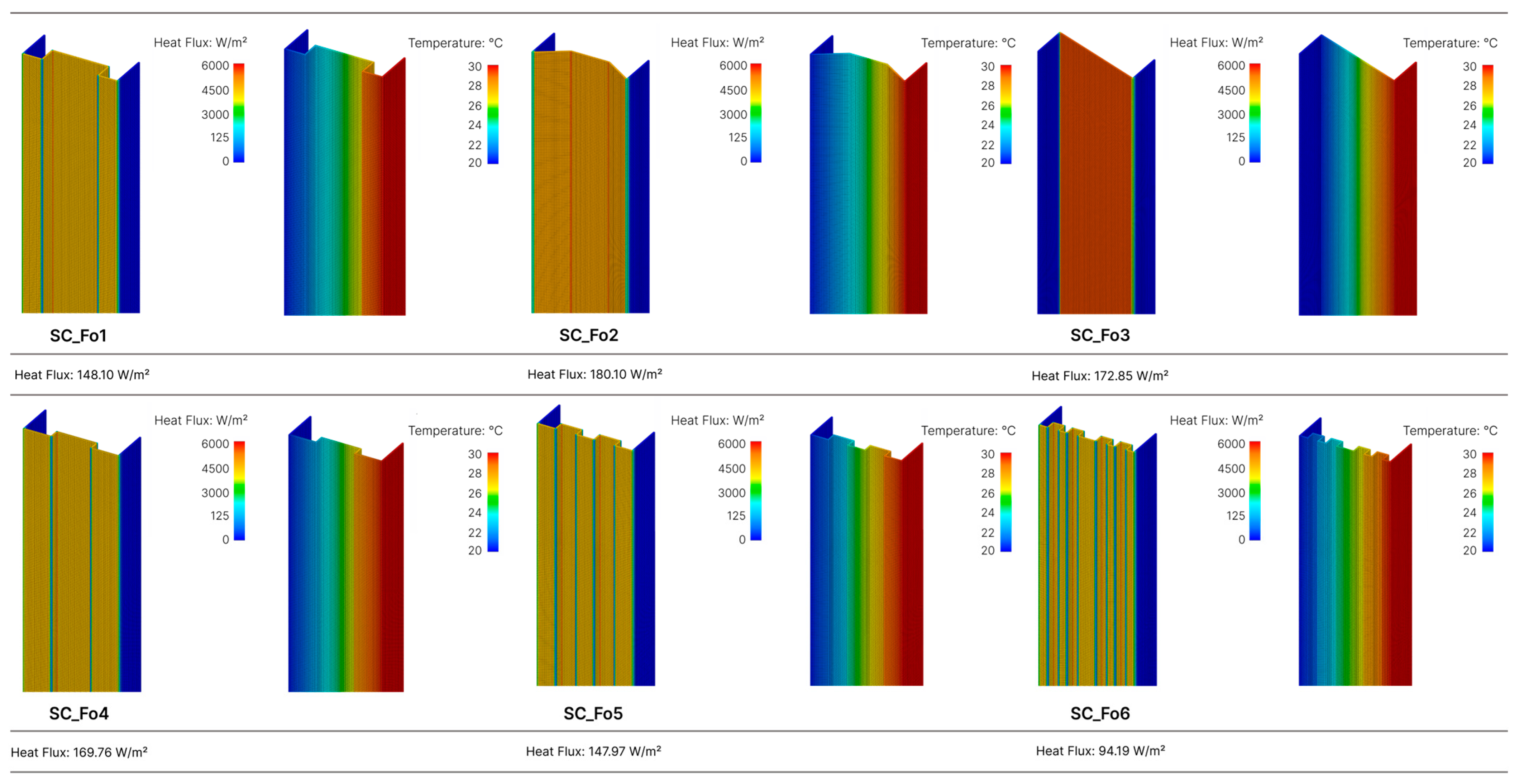
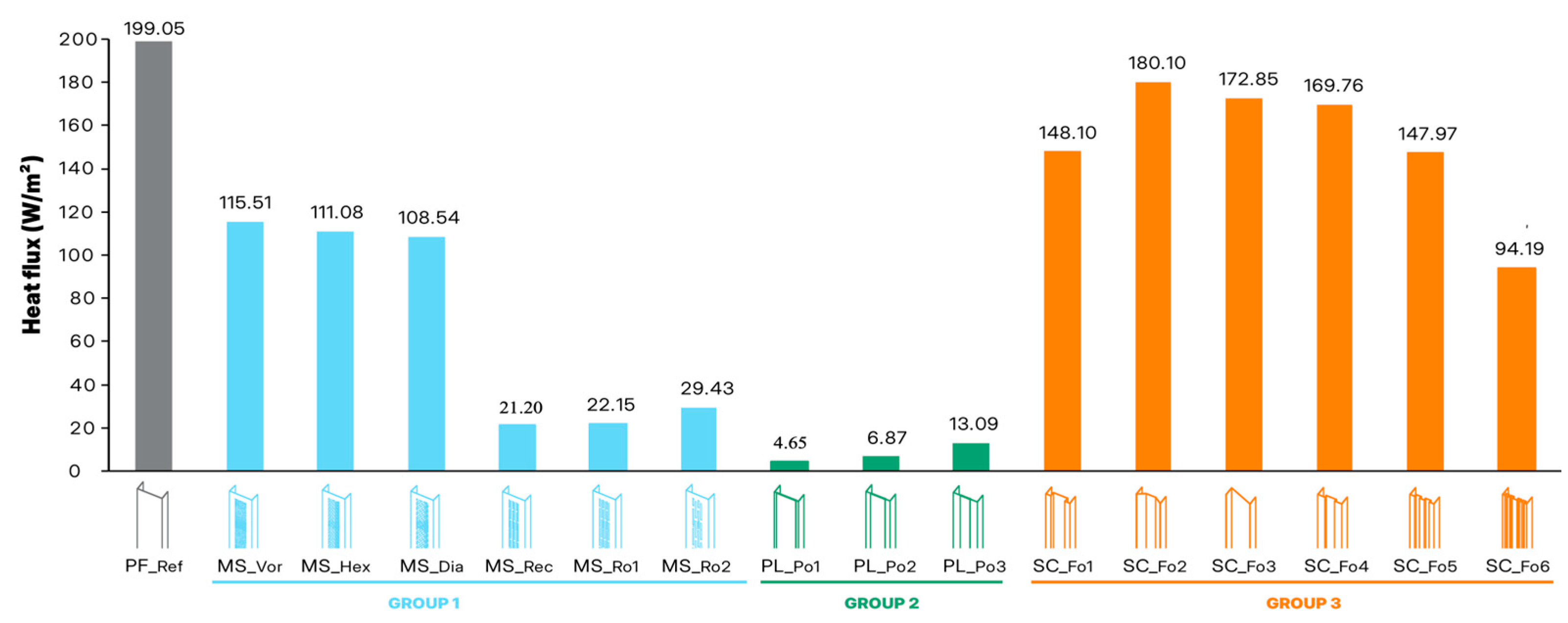
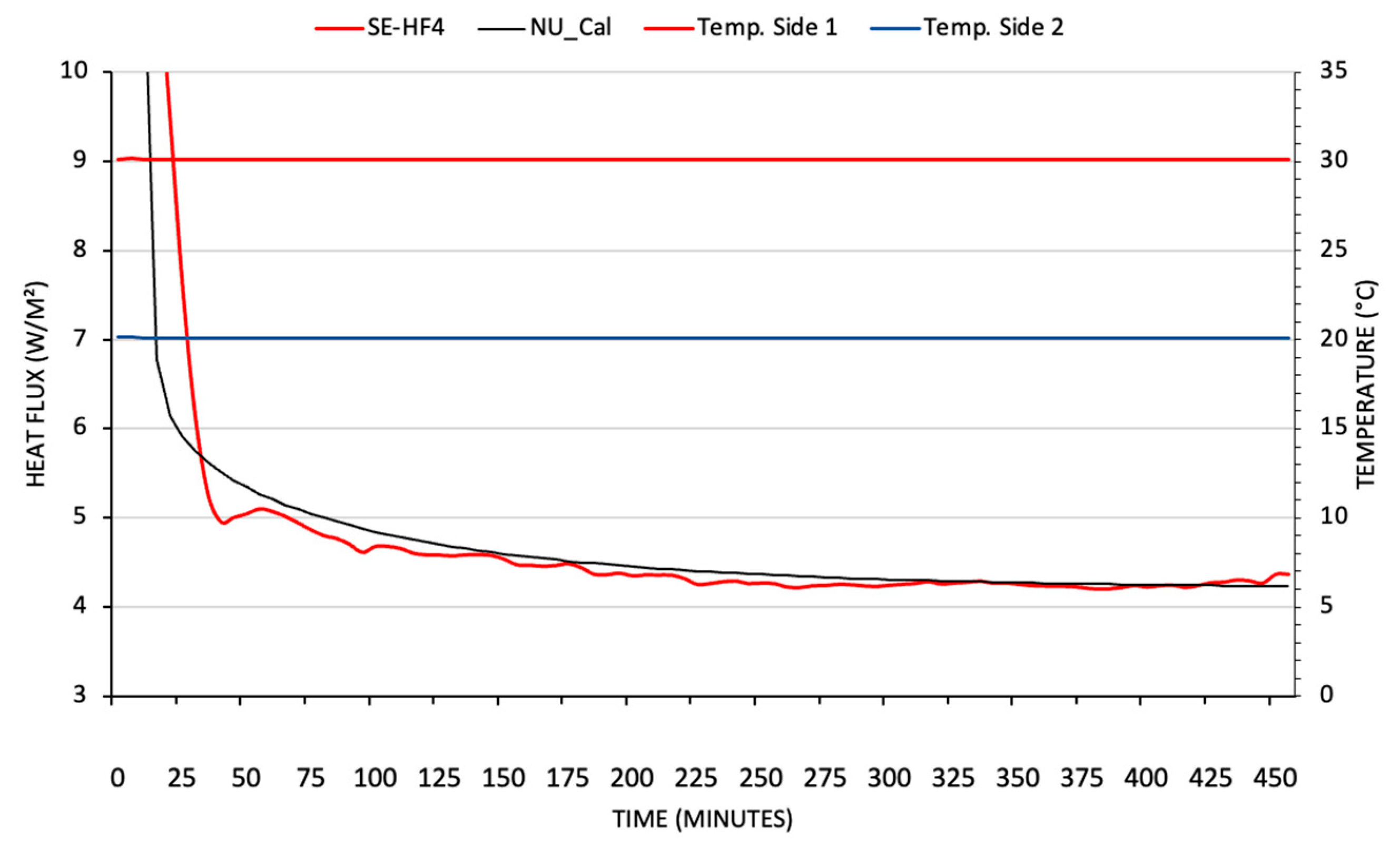
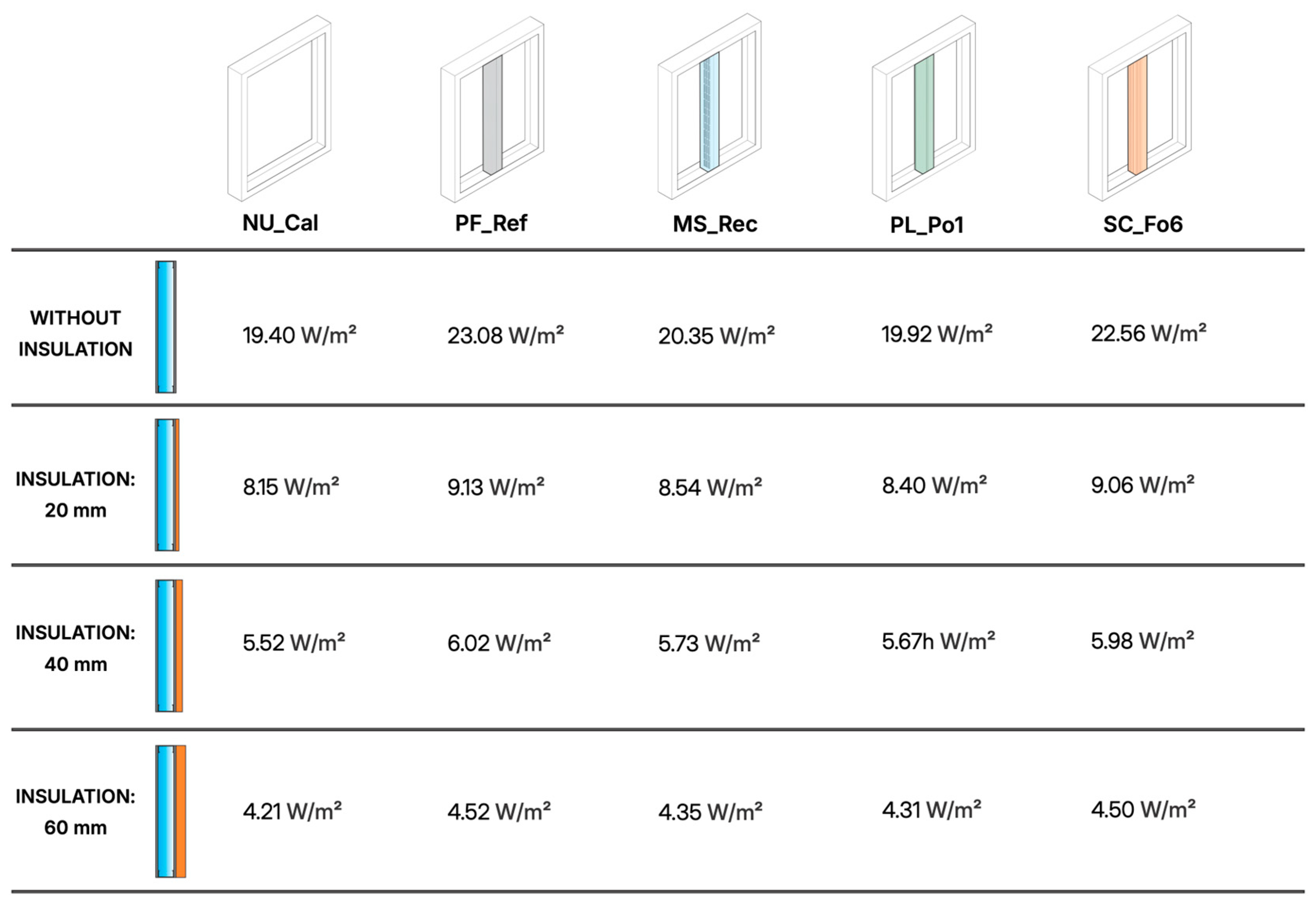

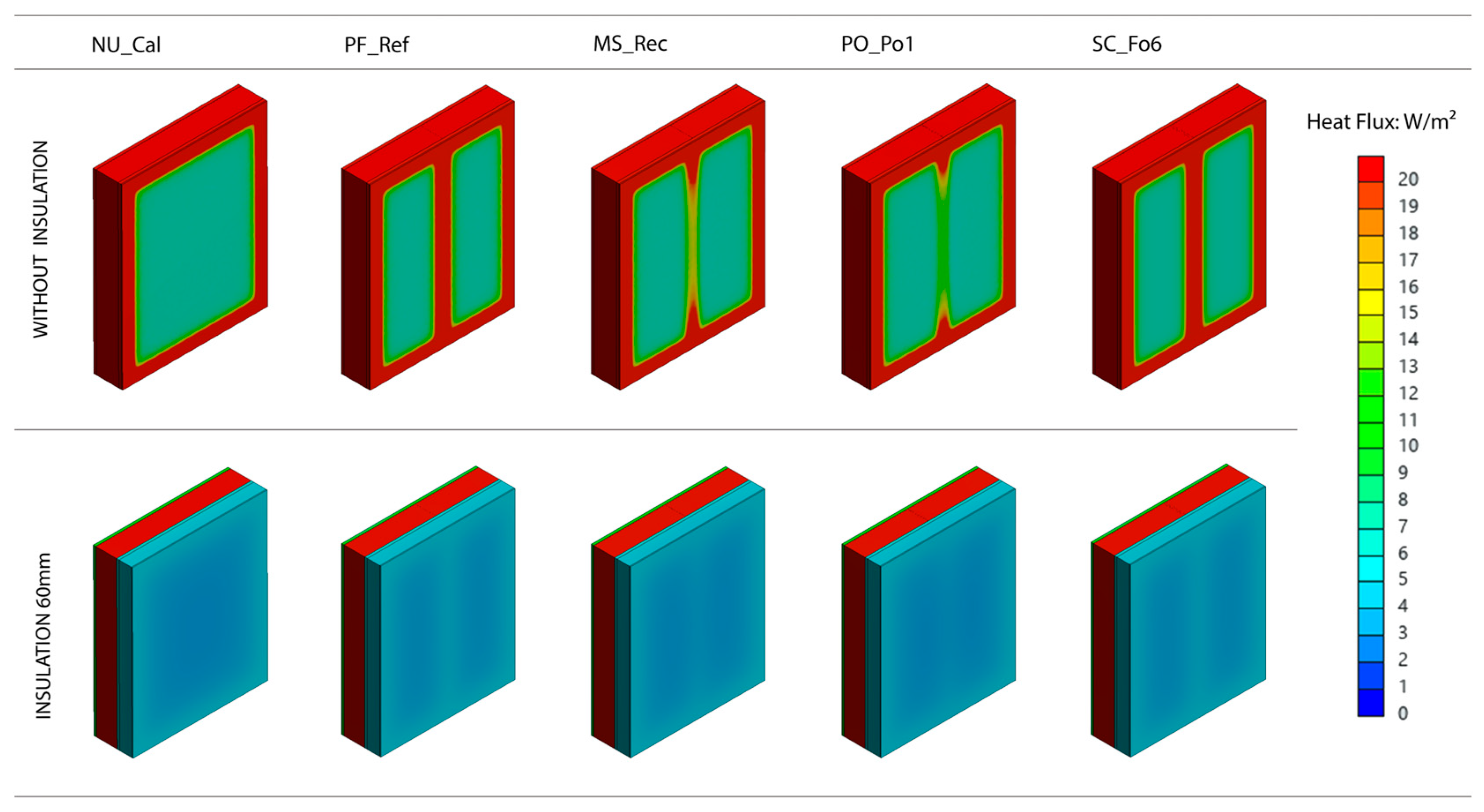
| Material (Supplier Data) | Thickness (mm) | Density (kg·m−3) | Thermal Conductivity (W·m−1·K−1) | Specific Heat (J·kg−1·K−1) |
|---|---|---|---|---|
| Finishing plaster | 5 | 1200 | 0.400 | 1090 |
| Glass wool | 60 | 115 | 0.034 | 840 |
| Glass fiber reinforced with gypsum board | 12.5 | 872 | 0.186 | 840 |
| Gypsum plasterboard | 12.5 | 944 | 0.250 | 950 |
| Cold-formed C 1.5 mm | 1.5 | 7850 | 60.50 | 434 |
| Finishing plaster | 5 | 1200 | 0.400 | 1090 |
Disclaimer/Publisher’s Note: The statements, opinions and data contained in all publications are solely those of the individual author(s) and contributor(s) and not of MDPI and/or the editor(s). MDPI and/or the editor(s) disclaim responsibility for any injury to people or property resulting from any ideas, methods, instructions or products referred to in the content. |
© 2025 by the authors. Licensee MDPI, Basel, Switzerland. This article is an open access article distributed under the terms and conditions of the Creative Commons Attribution (CC BY) license (https://creativecommons.org/licenses/by/4.0/).
Share and Cite
Langner, M.; Soares, T.A.; Figueiredo, A.; Almeida, R.M.S.F.; Vicente, R. Parametric Analysis of Steel Studs to Reduce Thermal Bridges in Light Steel Framing Construction Systems. Buildings 2025, 15, 194. https://doi.org/10.3390/buildings15020194
Langner M, Soares TA, Figueiredo A, Almeida RMSF, Vicente R. Parametric Analysis of Steel Studs to Reduce Thermal Bridges in Light Steel Framing Construction Systems. Buildings. 2025; 15(2):194. https://doi.org/10.3390/buildings15020194
Chicago/Turabian StyleLangner, Marcelo, Thais A. Soares, António Figueiredo, Ricardo M. S. F. Almeida, and Romeu Vicente. 2025. "Parametric Analysis of Steel Studs to Reduce Thermal Bridges in Light Steel Framing Construction Systems" Buildings 15, no. 2: 194. https://doi.org/10.3390/buildings15020194
APA StyleLangner, M., Soares, T. A., Figueiredo, A., Almeida, R. M. S. F., & Vicente, R. (2025). Parametric Analysis of Steel Studs to Reduce Thermal Bridges in Light Steel Framing Construction Systems. Buildings, 15(2), 194. https://doi.org/10.3390/buildings15020194









